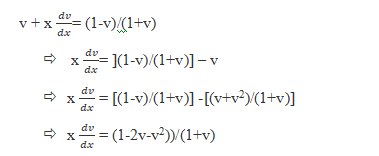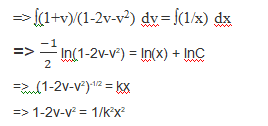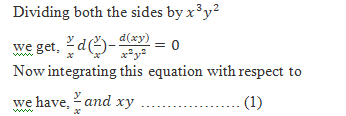- Books Name
- Mathmatics Book Based on NCERT
- Publication
- KRISHNA PUBLICATIONS
- Course
- CBSE Class 12
- Subject
- Mathmatics
Homogeneous differential equations
A function F(x, y) is said to be homogeneous function of degree n if
F(λx, λy) = λnF(x, y) for any nonzero constant λ .
A differential equation of the form ![]() is said to be homogenous if F(x, y) is a homogenous function of degree zero. We make the substitution y = v . x
is said to be homogenous if F(x, y) is a homogenous function of degree zero. We make the substitution y = v . x

Separating the variables in equation , we get

Integrating both sides of equation (5), we get

Equation (6) gives general solution (primitive) of the differential equation (1) when
we replace v by y/x.
Example: Solve dy/dx = (x-y)/(x+y)
Solution: Given, dy/dx = (x-y)/(x+y)
It is homogeneous degree 0.
![]()
Then,

Now we can use the separation of variables method;
(1+v)/(1-2v-v2) dv = (1/x) dx
Integrating both the sides;

Again, putting v = y/x;
1-2(y/x)-(y/x)2 = 1/k2x2
Eliminating x2 term from denominator on both the sides, we get;
x2-2xy-y2 = 1/k2
or
y2+2xy-x2 = -1/k2
Now, put -/k2 = c
Adding 2x2 on both the sides;
y2+2xy+x2 = c+2x2
Now factoring the above equation, we get;
(y+x)2 = 2x2+c
y+x=√(2x2)+c
Or y = ±√(2x2+c) − x
This is the solution for the given equation.
Example: Find the equation of the curve passing through the point (1,-2) when the tangent at any point is given by ![]()
Solution: The equation of tangent represents the slope of the curve i.e.
This equation is homogeneous in nature.
On cross-multiplication, we get- ![]()
Solving the equation, we get


Now substituting the value of the given point in the above equation, we have

Put this value of the constant C in equation (1) we get

This is the required solution.

 KRISHNA PUBLICATIONS
KRISHNA PUBLICATIONS
